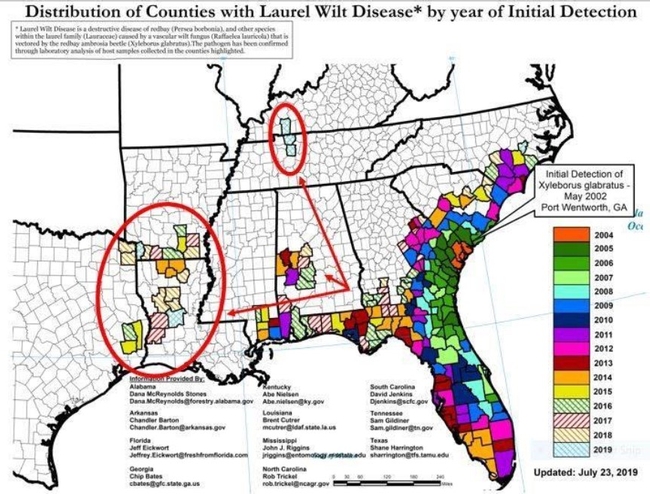UF/IFAS researchers are working on a decision-support app to help policy makers and growers decide the best regional treatment options for laurel wilt disease, which is challenging Florida's $35 million-a-year avocado crop.
Laurel wilt disease is spread by several ambrosia beetle vectors. People, whether they grow avocados or not, can spread the beetles when they move infested wood products – for example, firewood and wood-turner wood -- UF/IFAS researchers say. UF/IFAS researchers are trying to get all this spreading under control.
To help develop the app, scientists are using the HiPerGator, a supercomputer on the main University of Florida campus in Gainesville, to analyze massive amounts of data.
“This network analysis app will aid policy makers by providing input about how such things as subsidies or penalties for disease management are likely to affect growers' management decisions and resulting disease spread,” said Berea Etherton, a doctoral student in plant pathology in the UF/IFAS College of Agricultural and Life Sciences. “Better regional management as a whole benefits individual growers.”
Scientists hope to gain better regional control of laurel wilt through machine learning for analysis of satellite-images. Those analyses train an artificial intelligence system to recognize patterns from remotely sensed images, said Etherton, who's conducting the research under the supervision of her advisor, UF/IFAS Professor Karen Garrett.
“In the next steps for the project, we plan to integrate satellite image analysis and disease recognition to support decision makers considering the best management strategies,” Garrett said. “The computational demands of the machine-learning tools in this project will benefit from the new HiPerGator resources.”
The UF supercomputer will allow for rapid analysis of large data sets, Etherton said. This project is designed to pass the benefits of the HiPerGator on to the growers, as decision support will include input from satellite images and high-speed processing.
Florida avocados are grown almost entirely in Miami-Dade County. Many consumers love to eat them in a variety of ways, including in guacamole dip. But even as laurel wilt disease damages avocado trees, demand for the fruit continues to rise in global markets. According to UF/IFAS economists, about 80% of Florida's avocados are sold outside Florida and the industry has an economic impact of about $100 million to the state's economy.
Garrett and Etherton are working with researchers at the UF/IFAS Tropical Research and Education Center and the U.S. Department of Agriculture. They all hope the app will help control laurel wilt on a regional basis.
“Any technology that is accessible, efficacious and economical and helps producers combat laurel wilt is welcome,” said Jonathan Crane, UF/IFAS professor of horticulture and a tropical fruit Extension specialist at TREC.
“Managing crop diseases is challenging, because the success of one grower's management strategies often depends on how well other growers are managing the disease. We are working to contribute to regional management strategies,” Garrett said.
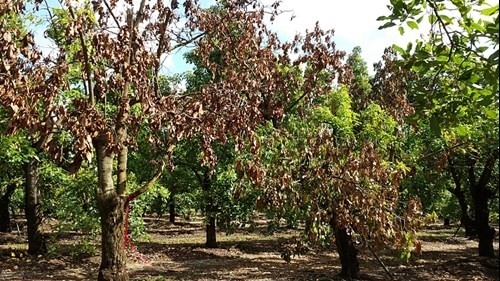
laurel wilt trees
Posted on
Wednesday, November 25, 2020 at
11:08 AM
- Author:
Brad Buck, U of F
Focus Area Tags: Agriculture
Current status of
Laurel Wilt: A Disease of Avocado
-
Please find enclosed links to a recent on-line meeting of researchers from forestry and avocado production system perspectives on current laurel wilt research. The goal of the meeting was to briefly share information on current basic and applied research and ideas for controlling or mitigating the laurel wilt pathogen and the ambrosia beetle vectors. Below is the agenda.
https://ufl.zoom.us/rec/share/6tdrHq3spkxLRKuS2VOFGaEzRaS7X6a80SUfrqYJnkuVYiHCDKUa5wtKYTp5ucdn
https://ufl.zoom.us/rec/share/6tdrHq3spkxLRKuS2VOFGaEzRaS7X6a80SUfrqYJnkuVYiHCDKUa5wtKYTp5ucdn
Laurel wilt is a notorious example of the destructive capacity of beetle-borne fungi. Even more importantly, there is a vibrant community of researchers studying it! At this meeting we will host scientists and students that are actively solving the mysteries of this epidemic. We will hear about many topics, from glowing transgenic pathogen strains to field detection with sniffer dogs.
We hope that the laurel wilt community will also benefit from what our BBM Network has to offer. Exchanging results and experiences is important for the PIs, but perhaps even more for the students – designing and executing a laurel wilt related-project takes a long time, so it might be beneficial to get feedback earlier than at the publication stage. We see repeated mistakes that could be prevented, and old questions that would have been answered, if we talked more as a community. And how about people studying different ambrosia symbioses, beetles or pathogens? There is a lot of overlap but little information exchange with those outside of our field.
Participants
INTRODUCTION AND WELCOME
- 9:00 Jiri Hulcr: Short introduction to the Bark Beetle Mycobiome group (5 minutes)
MOLECULAR BIOLOGY
- Josh Konkol: GFP strain, colonization of the host plant by R. lauricola
- Jeff Rollins: Studying R. lauricola pathogenesis through comparative genomics and transcriptomics
- Qiang Wang: CRISPR-homologous recombination methods and deletion of genes from R. lauricola
- Ross A. Joseph: Swap of multiple GFP-labeled strains inside the vector
BIOLOGY
- Octavio Menocal Sandoval: Breeding Xyleborus, behavior of mating and symbiont swap
- Daniel Carrillo: Laurel wilt vectors in avocado
- Kirsten Stelinski: TBD
ECOLOGY,
- Denita Hadziabdic: Laurel wilt advancing North
- Robin Choudhury: LW dispatch from the Texas front
- Andrés Lira Noriega: Modelling for risk assessment of laurel wilt in Mexico
- Jason Smith: Redbay heritable resistance and rebounding populations
DETECTION
- Caterina Villari: Detection of laurel wilt pathogen in the field with LAMP
- DeEtta (Dee) Mills: Detector dogs
- Pedro Parra Giraldo: Culture-independent Laurel Wilt diagnosis in avocado groves
MANAGEMENT
- Romina Gazis: Testing “Out-Of-The-Box” Ideas to Control Laurel Wilt of Avocado
- José Luis Olivares-Romero: Synthesis of novel insecticides for the management of ambrosia beetles
- Jonathan Crane: Laurel wilt status in avocado groves and grower-initiated control
- Xavier Martini and Derrick Connover: Push-pull system to protect redbay and avocado against Laurel Wilt
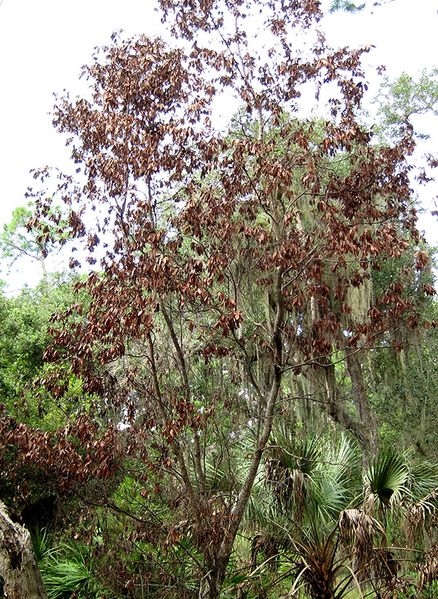
red bay killed by laurel wilt
Posted on
Thursday, May 21, 2020 at
12:53 PM
Focus Area Tags: Agriculture
Laurel Wilt Disease of Avocado and the relatives of avocado in the Laurel Family has devastated the the forests along the east coast from North Carolina down to Florida and along the Caribbean into Texas. It has caused significant losses to wildlands and to the Florida avocado industry.
The extent of the native tree loss is shocking and there is very little that can be done to correct the problem, other than to curb the spread of contaminated wood that is spread by humans, There has been some success in the avocado orchards. While there is no "silver bullet", there is some progress, e.g. pruning to increase light levels to suppress Ambrosia Beetle activity. In addition, research has continued for:
- Vaccinations to protect avocado trees from the LW pathogen
- Developing a faster LW diagnostic tool
- Screening scions and rootstocks for tolerance/resistance
- AB control tactics and suppression
- Molecular understanding of the pathogen
- Economics and the LW epidemic
Read the latest results in these two recent publications:
Recommendations for the Detection and Mitigation of Laurel Wilt Disease in Avocado and Related Tree Species in the Home Landscape
Recommendations for Control and Mitigation of Laurel Wilt and Ambrosia Beetle Vectors in Commercial Avocado Groves in Florida1
Photo: Dead avocado trees from Laurel Wilt in Florida
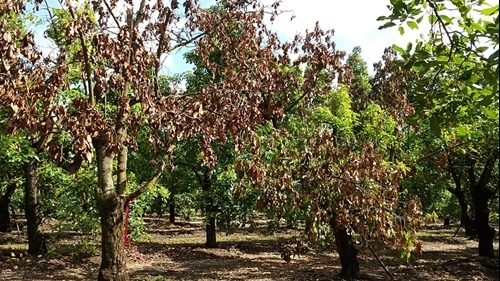
laurel wilt trees
Posted on
Wednesday, April 22, 2020 at
7:19 AM
Focus Area Tags: Agriculture
Laurel Wilt Disease has been on the radar since 2002 when it became apparent that trees related to avocado were dying in the Georgia area. The Lauraceae family comprises a major portion of the evergreen tree species in the southeast. It's a fungal disease spread by the red bay ambrosia beetle. Since its introduction, the pest/disease complex has spread throughout the Southeast US, causing significant death and economic loss in forested areas. Since about 2011, it has been causing significant damage to the avocado groves in the Miami area. A massive amount of energy has been put into studying the control of the disease, but as yet, there are no clear solutions once a tree is infected. Tree removal is the answer to contain the spread.
This is a grower letter describing the frustration of dealing with Laurel Wilt Disease in Florida and an alert to California growers to get prepared for it.
Homestead, Florida
(305) 972-9499
cdlt1948@yahoo.com
DLT Farms LLC
October 27, 2019
Open Letter to Avocado Producers:
I grow tropical avocados commercially in Homestead, Florida. That's been my passion for the last 16 years, The last five years have been a frustrating nightmare caused by Laurel Wilt. This morning I marked three more trees for extraction in addition to the 10 trees I marked three days ago. I lose about 20-25 a month and it's on the rise.
The largest avocado-producing areas are free of the problem at the moment. In South Florida, tropical avocado is a very small industry with little economic and political influence, as a result not much attention is paid to this crises. In the Homestead, Florida avocado region the pathogen and vectors are everywhere. There are orchards that disappear from one year to the next. Unfortunately, we have been on the front lines of this disease.
This creates an opportunity for the rest of the avocado producing areas, so far free of this disease to do research in this area. There is a lot of research to be done and as time goes on we gain more experience. Here, there is access to adult trees in the field for testing and research. This is not the case for areas in which the disease has not made its appearance.
I only mention some investigations that could be pending:
Some trees die in a week, however there are trees that look resistant to Laurel Wilt, they have tested positive from root to canopy, proven on multiple occasions and methodologies, yet they are still alive and show no symptoms of the wilt. I know of two, one in particular I call 9-7, is positive since January 2019 and continues alive and recovering. Personally I think this tree is talking to us, however there are no funds to see what it tells us.
Early detection in the process is vital to early removal of diseased trees, before other trees acquire the disease. It is essential to determine whether the tree is contaminated with little pathogen, to extract it before it contaminates adjacent trees. There is no data on the time between when a tree is contaminated and when the first sign of "sadness" becomes visible. Less than a week ago I detected a little sadness in a branch. When cutting it, it looked positive for wilt, I continued to check three more trees on the same row and all three tested positive at various levels without visible symptoms. Root contamination moves unnoticed for weeks or months. This type of root contagion remains an observable presumption of farmers and has not been investigated.
Some producers believe that there are two or more strains of the fungus that causes the disease, (Raffaelea Lauricola), one much more aggressive than others. A full DNA study is complicated and costly. As I understand it, it hasn't been done and there are no plans.
Other producers began doing thermal treatments on infected and stumped trees. I tried on 8 of my trees. All are alive and doing well, the two oldest are 17 months old and continue to grow. On the other hand, the eight have tested positive for Laurel Wilt, post-treatment. There is no scientific data to understand what is going on and what opportunities this offers.
What attracts vectors and what can farmers do? Many growers are gaining experience of their own. I stopped injecting phosphorous acid to treat Phytophthora because I have noticed that these trees have a higher frequency of vector inoculation than others not injected. I suspect why, but we don't have a scientific foundation to know what's going on.
Can trees be vaccinated with some form of vaccine to increase resistance or defense against the pathogen?
And so on, I could mention a lot more.
Looking back we knew it was coming, but we didn't prepare enough, partly because it wasn't always easy to test in the field and there were a lot of restrictions on conducting test in greenhouses and we just didn't believe it or wanted to invest funds in research. Some thought it would never come.
We all see these bark beetles moving around the world with little or no restriction. One day any area can wake up to the bad news.
I can tell you this: you can imagine this disease in your grove, more or less we know what it does, you can read articles, watch YouTube videos, after you finish your imagination exercise, I can tell you as a grower dealing with this every day, MULTIPLY IT BY 10 !
Please, support research in the area where it can best be done. Get ahead of it.
Signed,
Carlos de la Torre
Keep abreast of Laurel Wilt Disease!
You can see presentations that have been made by a University of Florida research contingent which spoke to avocado growers this summer, 2019:
Laurel Wilt Presentations
You can also hear a webinar about the pest/disease complex by UCR's Monique Rivera:
Laurel Wilt Talk
Photos: Symptoms of Laurel Wilt Disease in avocado. Distribution map over time of Laurel Wilt Disease in the Southeast. Image of Georgia forest affected by Laurel Wilt Disease.
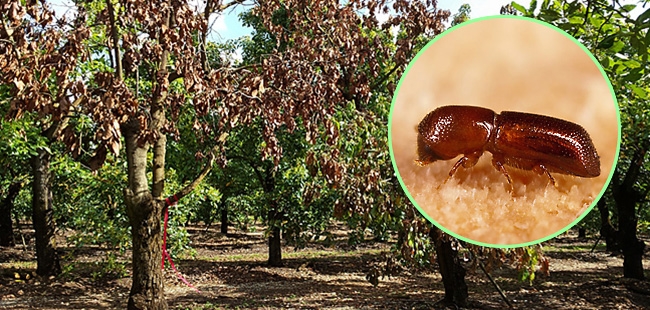
laurel-wilt-and-avocado-trees
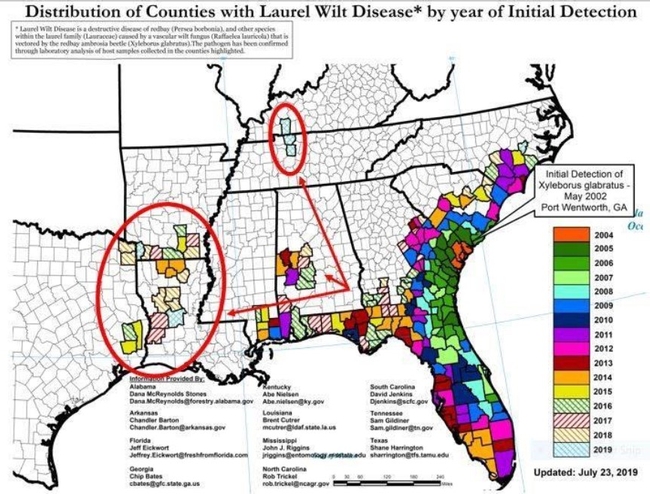
Laurel wilt map
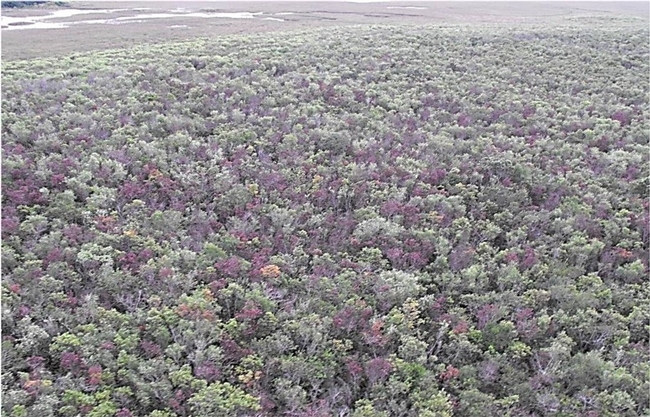
laurel wilt forest death
Posted on
Tuesday, October 29, 2019 at
3:44 PM
Laurel Wilt Disease (LWD) is caused by the fungus Raffaelea lauricola and is transmitted to host trees by the redbay ambrosia beetle (Xyloborus glabratus) (RAB). During 2002 this exotic beetle was introduced into Port Wentworth, GA, via infested solid wood packing material. Since then, LWD has spread naturally the RAB vector and humnan movement of infested wood throughout the southeastern U.S. (GA, SC, NC, FL, and MS), eliminating redbay (P. borbonia), swampbay (P. palustris) and other native members of this family. This pest has spread to most counties in Florida and to the commercial avocado-growing area near Miami.
Trees in the Lauracae, including the commercially important avocado (Persea americana Mill.) are threatened by laurel wilt (LWD). Research has shown that avocado trees are susceptible to attack by the RAB and susceptible to LWd. In Jan., 2010, the RAB was detected approximately 16 km from the edge of Florida's primary commercial avocado production area in southeastern Miami-Dade County, and in Feb., 2011 LWD was confirmed in dying swampbay trees in the same area. As of April 2012, LWD was confirmed in several commercial avocado groves in the northeastern section of the industry. Despite intensive research since 2006, no economically viable chemical control measures have been found to combat LWD. However, on-going research is promising and has provided the researcher and extension scientists the basis for suppression of RAB and the spread of LWD. Thus, detection and immediate suppression of outbreaks of LWD within the avocado production area is viewed as the most appropriate LW management strategy.
A group of Florida researchers recently visited with CA growers to about their progress confronting this problem. Their talks are available for review at this site:
http://ceventura.ucanr.edu/Com_Ag/Subtropical/Avocado_Handbook/Laurel_Wilt_Disease_in_Florida/
Photo: A Fast Death for an Avocado
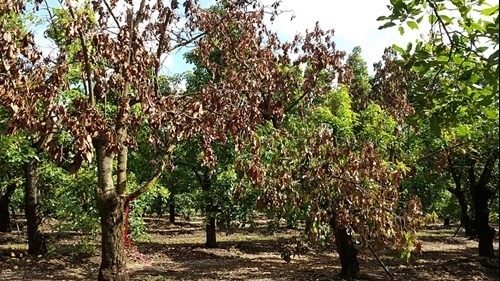
laurel wilt trees
Posted on
Wednesday, August 7, 2019 at
5:36 AM








